2013 FORD EXPLORER seats
[x] Cancel search: seatsPage 33 of 576
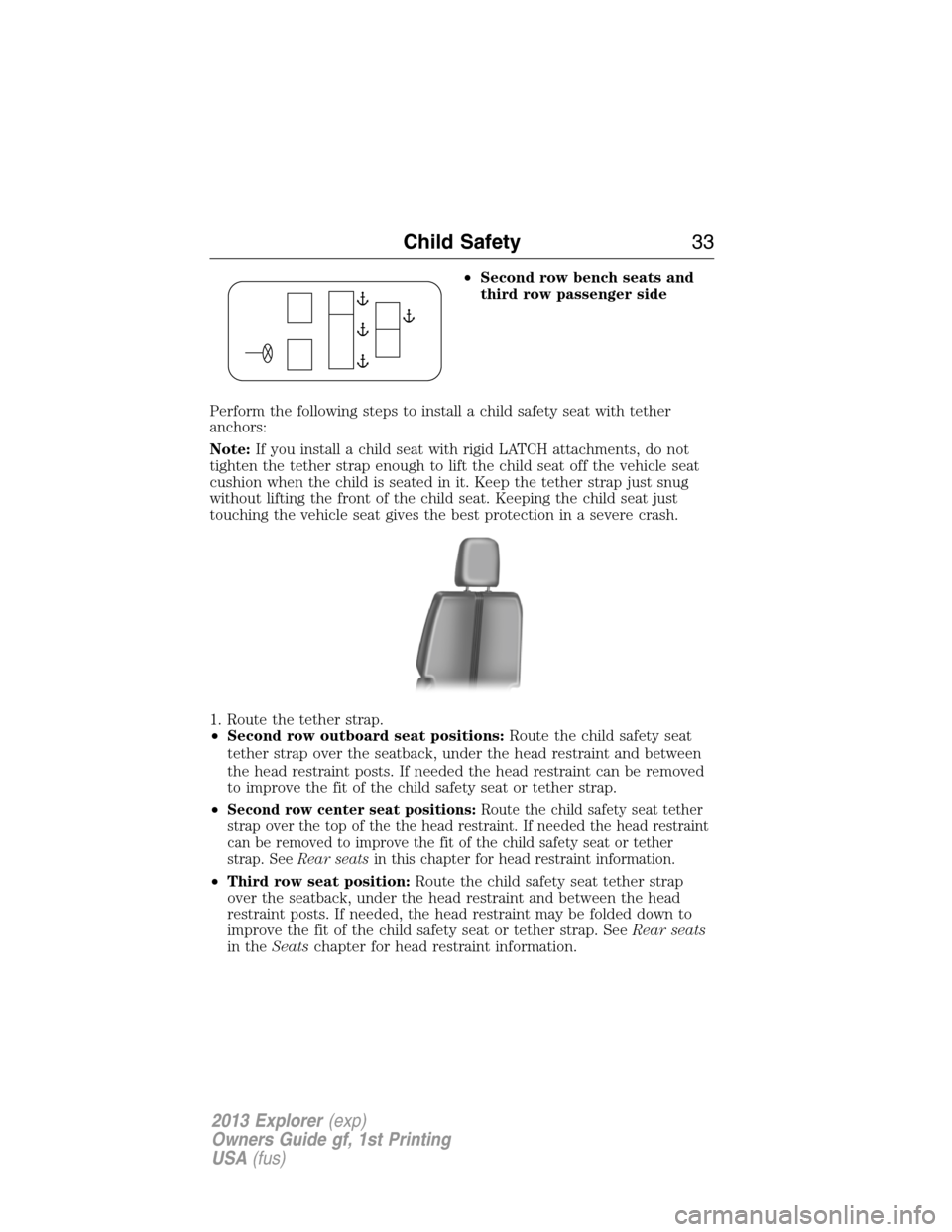
•Second row bench seats and
third row passenger side
Perform the following steps to install a child safety seat with tether
anchors:
Note:If you install a child seat with rigid LATCH attachments, do not
tighten the tether strap enough to lift the child seat off the vehicle seat
cushion when the child is seated in it. Keep the tether strap just snug
without lifting the front of the child seat. Keeping the child seat just
touching the vehicle seat gives the best protection in a severe crash.
1. Route the tether strap.
•Second row outboard seat positions:Route the child safety seat
tether strap over the seatback, under the head restraint and between
the head restraint posts. If needed the head restraint can be removed
to improve the fit of the child safety seat or tether strap.
•
Second row center seat positions:Route the child safety seat tether
strap over the top of the the head restraint. If needed the head restraint
can be removed to improve the fit of the child safety seat or tether
strap. SeeRear seatsin this chapter for head restraint information.
•Third row seat position:Route the child safety seat tether strap
over the seatback, under the head restraint and between the head
restraint posts. If needed, the head restraint may be folded down to
improve the fit of the child safety seat or tether strap. SeeRear seats
in theSeatschapter for head restraint information.
Child Safety33
2013 Explorer(exp)
Owners Guide gf, 1st Printing
USA(fus)
Page 37 of 576

PRINCIPLES OF OPERATION
WARNING:Always drive and ride with your seatback upright
and the lap belt snug and low across the hips.
WARNING:To reduce the risk of injury, make sure children sit
where they can be properly restrained.
WARNING:Never let a passenger hold a child on his or her lap
while the vehicle is moving. The passenger cannot protect the
child from injury in a collision.
WARNING:All occupants of the vehicle, including the driver,
should always properly wear their safety belts, even when an
airbag supplemental restraint system (SRS) is provided.
WARNING:It is extremely dangerous to ride in a cargo area,
inside or outside of a vehicle. In a collision, people riding in these
areas are more likely to be seriously injured or killed. Do not allow
people to ride in any area of your vehicle that is not equipped with
seats and safety belts. Be sure everyone in your vehicle is in a seat and
using a safety belt properly.
WARNING:In a rollover crash, an unbelted person is
significantly more likely to die than a person wearing a safety
belt.
WARNING:Each seating position in your vehicle has a specific
safety belt assembly which is made up of one buckle and one
tongue that are designed to be used as a pair. 1) Use the shoulder belt
on the outside shoulder only. Never wear the shoulder belt under the
arm. 2) Never swing the safety belt around your neck over the inside
shoulder. 3) Never use a single belt for more than one person.
WARNING:When possible, all children 12 years old and under
should be properly restrained in a rear seating position.
Safety Belts37
2013 Explorer(exp)
Owners Guide gf, 1st Printing
USA(fus)
Page 38 of 576

WARNING:Safety belts and seats can become hot in a vehicle
that has been closed up in sunny weather; they could burn a
small child. Check seat covers and buckles before you place a child
anywhere near them.
WARNING:Front and rear seat occupants, including pregnant
women, should wear safety belts for optimum protection in an
accident.
All seating positions in this vehicle have lap and shoulder safety belts. All
occupants of the vehicle should always properly wear their safety belts,
even when an airbag supplemental restraint system is provided.
The safety belt system consists of:
•Lap and shoulder safety belts.
•Shoulder safety belt with automatic locking mode, (except driver and
rear inflatable safety belt).
•Height adjuster at the front outboard seating positions
•Retractor and anchor pretensioner at the front outboard seating
positions.
•Belt tension sensor at the front outboard passenger seating position.
•Safety belt warning light and chime. Refer toSafety Belt
Warning Light and Indicator Chimelater in this chapter.
•Crash sensors and monitoring system with readiness
indicator. Refer toCrash Sensors and Airbag Indicatorin
theSupplemental Restraint Systemchapter.
The safety belt pretensioners and rear inflatable safety belts are designed
to activate in frontal, near-frontal and side collisions, and in rollovers.
The safety belt pretensioners on the retractor and anchor at the front
seating positions are designed to tighten the safety belts firmly against
the occupant’s body when activated. This helps increase the effectiveness
of the safety belts. In frontal collisions, the safety belt pretensioners can
be activated alone or, if the collision is of sufficient severity, together
with the front airbags.
38Safety Belts
2013 Explorer(exp)
Owners Guide gf, 1st Printing
USA(fus)
Page 40 of 576

Pregnant women should always
wear their safety belt. The lap belt
portion of a combination lap and
shoulder belt should be positioned
low across the hips below the belly
and worn as tight as comfort will
allow. The shoulder belt should be
positioned to cross the middle of
the shoulder and the center of the
chest.
Safety Belt Locking Modes
WARNING:After any vehicle collision, the safety belt system at
all passenger seating positions must be checked by an authorized
dealer to verify that the automatic locking retractor feature for child
seats is still functioning properly. In addition, all safety belts should be
checked for proper function.
WARNING:BELT AND RETRACTOR ASSEMBLY MUST BE
REPLACED if the safety belt assembly automatic locking retractor
feature or any other safety belt function is not operating properly when
checked by an authorized dealer. Failure to replace the belt and retractor
assembly could increase the risk of injury in collisions.
All safety restraints in the vehicle are combination lap and shoulder belts.
The driver safety belt has the first locking mode and the front outboard
passenger and rear seat safety belts have both types of locking modes
described as follows:
Vehicle sensitive mode:This is the normal retractor mode, which
allows free shoulder or lap belt length adjustment to your movements
and locking in response to vehicle movement. For example, if the driver
brakes suddenly or turns a corner sharply, or the vehicle receives an
impact of approximately 5 mph (8 km/h) or more, the combination safety
belts will lock to help reduce forward movement of the driver and
passengers.
In addition, the retractor(s) is designed to lock if the webbing is pulled
out too quickly. If this occurs, let the belt retract slightly and pull
webbing out again in a slow and controlled manner.
40Safety Belts
2013 Explorer(exp)
Owners Guide gf, 1st Printing
USA(fus)
Page 46 of 576
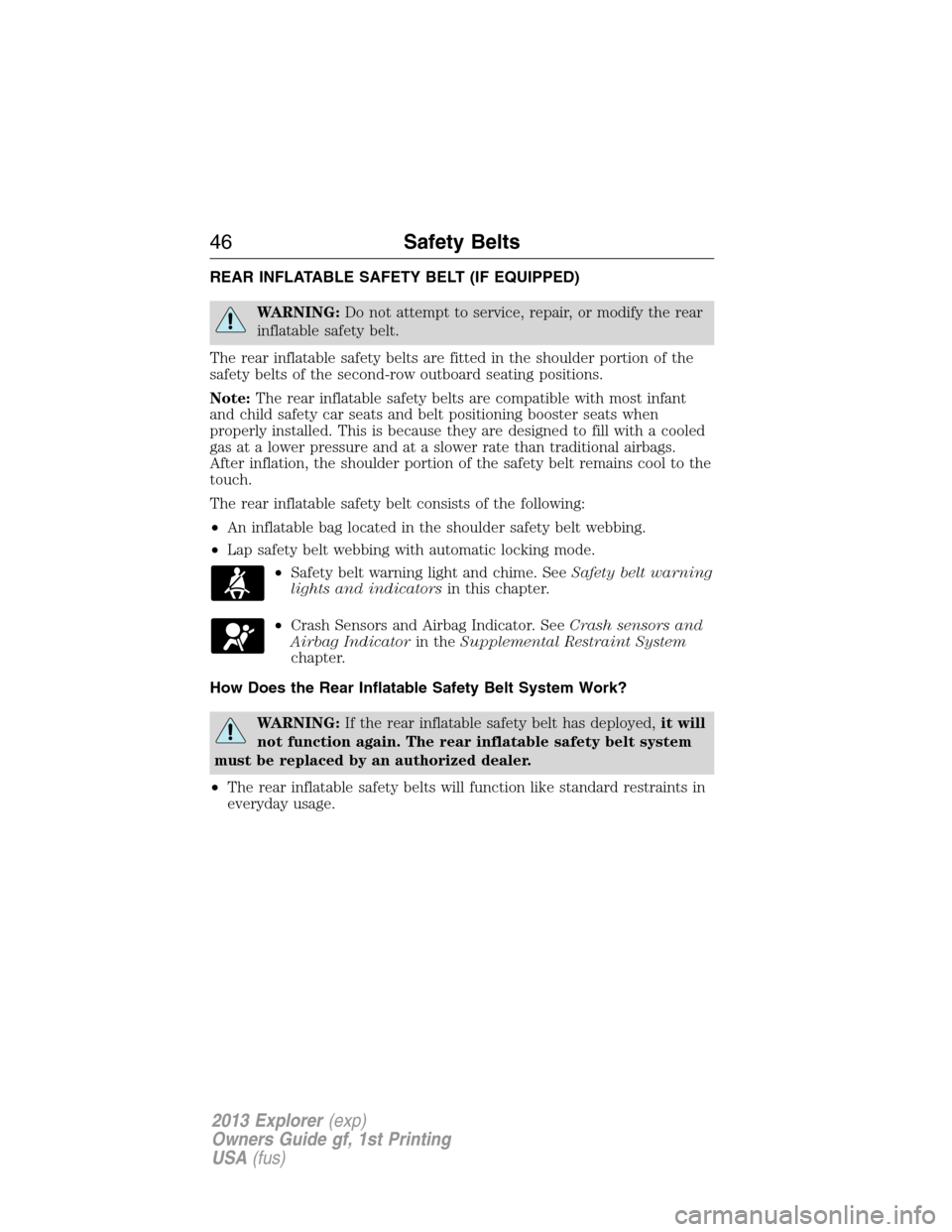
REAR INFLATABLE SAFETY BELT (IF EQUIPPED)
WARNING:Do not attempt to service, repair, or modify the rear
inflatable safety belt.
The rear inflatable safety belts are fitted in the shoulder portion of the
safety belts of the second-row outboard seating positions.
Note:The rear inflatable safety belts are compatible with most infant
and child safety car seats and belt positioning booster seats when
properly installed. This is because they are designed to fill with a cooled
gas at a lower pressure and at a slower rate than traditional airbags.
After inflation, the shoulder portion of the safety belt remains cool to the
touch.
The rear inflatable safety belt consists of the following:
•An inflatable bag located in the shoulder safety belt webbing.
•Lap safety belt webbing with automatic locking mode.
•Safety belt warning light and chime. SeeSafety belt warning
lights and indicatorsin this chapter.
•Crash Sensors and Airbag Indicator. SeeCrash sensors and
Airbag Indicatorin theSupplemental Restraint System
chapter.
How Does the Rear Inflatable Safety Belt System Work?
WARNING:If the rear inflatable safety belt has deployed,it will
not function again. The rear inflatable safety belt system
must be replaced by an authorized dealer.
•The rear inflatable safety belts will function like standard restraints in
everyday usage.
46Safety Belts
2013 Explorer(exp)
Owners Guide gf, 1st Printing
USA(fus)
Page 52 of 576
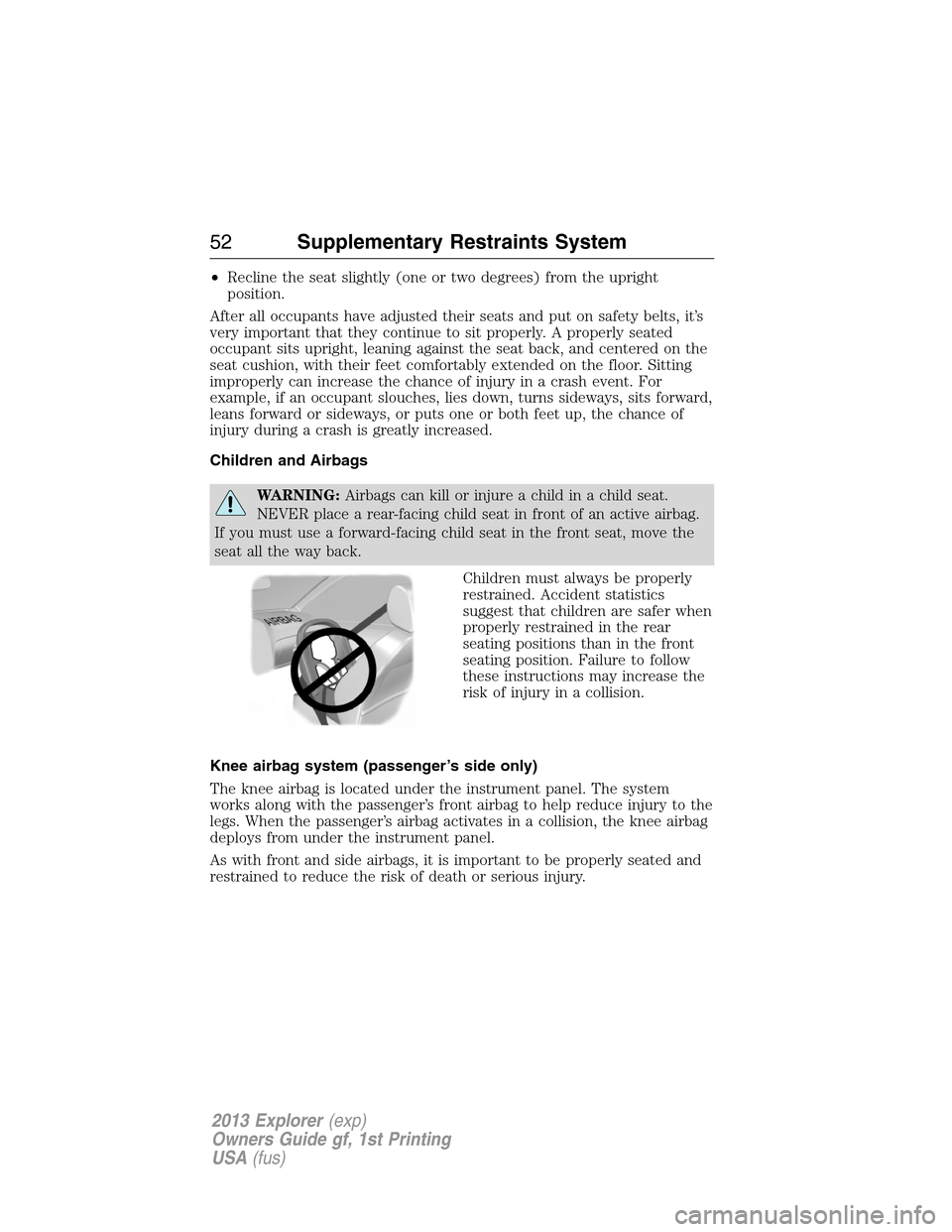
•Recline the seat slightly (one or two degrees) from the upright
position.
After all occupants have adjusted their seats and put on safety belts, it’s
very important that they continue to sit properly. A properly seated
occupant sits upright, leaning against the seat back, and centered on the
seat cushion, with their feet comfortably extended on the floor. Sitting
improperly can increase the chance of injury in a crash event. For
example, if an occupant slouches, lies down, turns sideways, sits forward,
leans forward or sideways, or puts one or both feet up, the chance of
injury during a crash is greatly increased.
Children and Airbags
WARNING:Airbags can kill or injure a child in a child seat.
NEVER place a rear-facing child seat in front of an active airbag.
If you must use a forward-facing child seat in the front seat, move the
seat all the way back.
Children must always be properly
restrained. Accident statistics
suggest that children are safer when
properly restrained in the rear
seating positions than in the front
seating position. Failure to follow
these instructions may increase the
risk of injury in a collision.
Knee airbag system (passenger’s side only)
The knee airbag is located under the instrument panel. The system
works along with the passenger’s front airbag to help reduce injury to the
legs. When the passenger’s airbag activates in a collision, the knee airbag
deploys from under the instrument panel.
As with front and side airbags, it is important to be properly seated and
restrained to reduce the risk of death or serious injury.
52Supplementary Restraints System
2013 Explorer(exp)
Owners Guide gf, 1st Printing
USA(fus)
Page 55 of 576
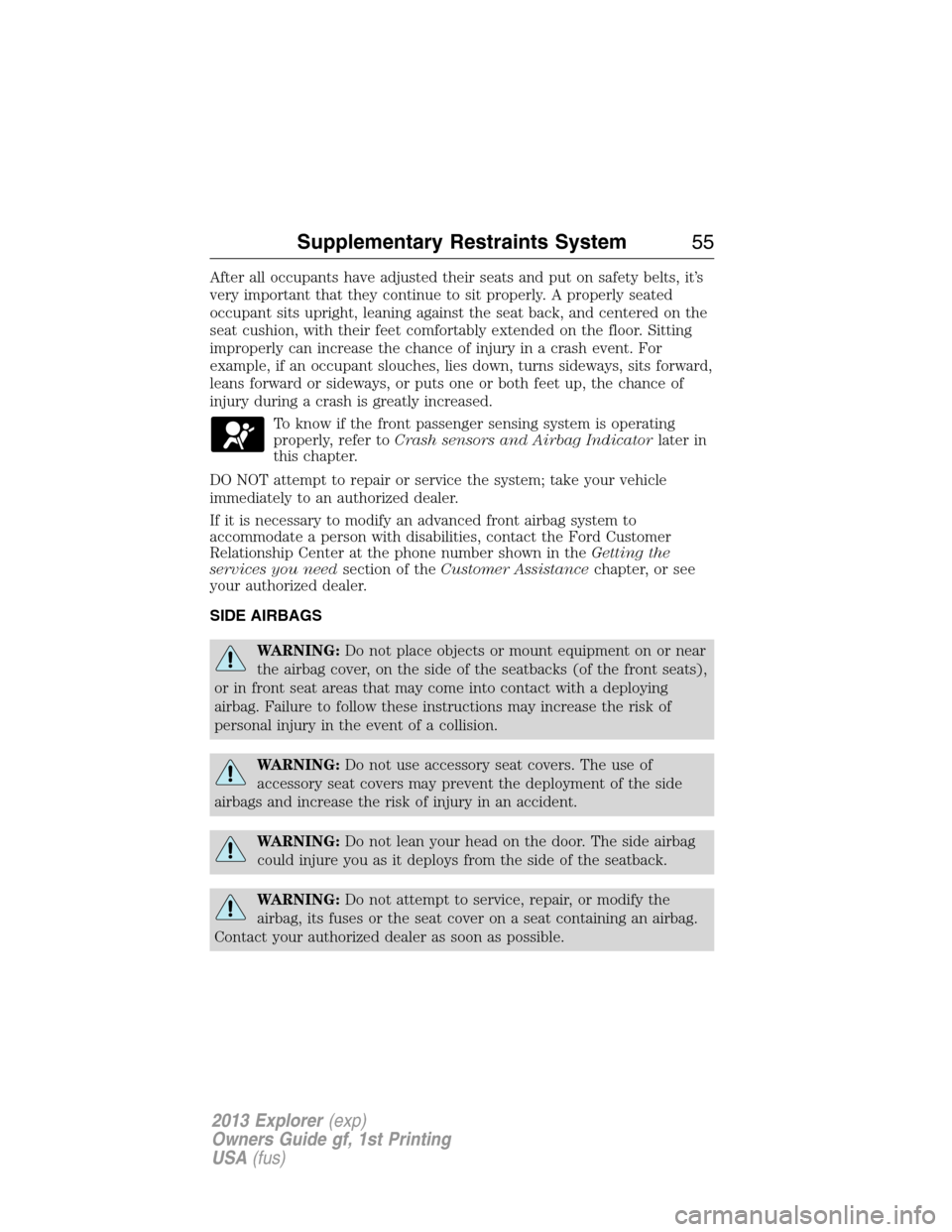
After all occupants have adjusted their seats and put on safety belts, it’s
very important that they continue to sit properly. A properly seated
occupant sits upright, leaning against the seat back, and centered on the
seat cushion, with their feet comfortably extended on the floor. Sitting
improperly can increase the chance of injury in a crash event. For
example, if an occupant slouches, lies down, turns sideways, sits forward,
leans forward or sideways, or puts one or both feet up, the chance of
injury during a crash is greatly increased.
To know if the front passenger sensing system is operating
properly, refer toCrash sensors and Airbag Indicatorlater in
this chapter.
DO NOT attempt to repair or service the system; take your vehicle
immediately to an authorized dealer.
If it is necessary to modify an advanced front airbag system to
accommodate a person with disabilities, contact the Ford Customer
Relationship Center at the phone number shown in theGetting the
services you needsection of theCustomer Assistancechapter, or see
your authorized dealer.
SIDE AIRBAGS
WARNING:Do not place objects or mount equipment on or near
the airbag cover, on the side of the seatbacks (of the front seats),
or in front seat areas that may come into contact with a deploying
airbag. Failure to follow these instructions may increase the risk of
personal injury in the event of a collision.
WARNING:Do not use accessory seat covers. The use of
accessory seat covers may prevent the deployment of the side
airbags and increase the risk of injury in an accident.
WARNING:Do not lean your head on the door. The side airbag
could injure you as it deploys from the side of the seatback.
WARNING:Do not attempt to service, repair, or modify the
airbag, its fuses or the seat cover on a seat containing an airbag.
Contact your authorized dealer as soon as possible.
Supplementary Restraints System55
2013 Explorer(exp)
Owners Guide gf, 1st Printing
USA(fus)
Page 56 of 576
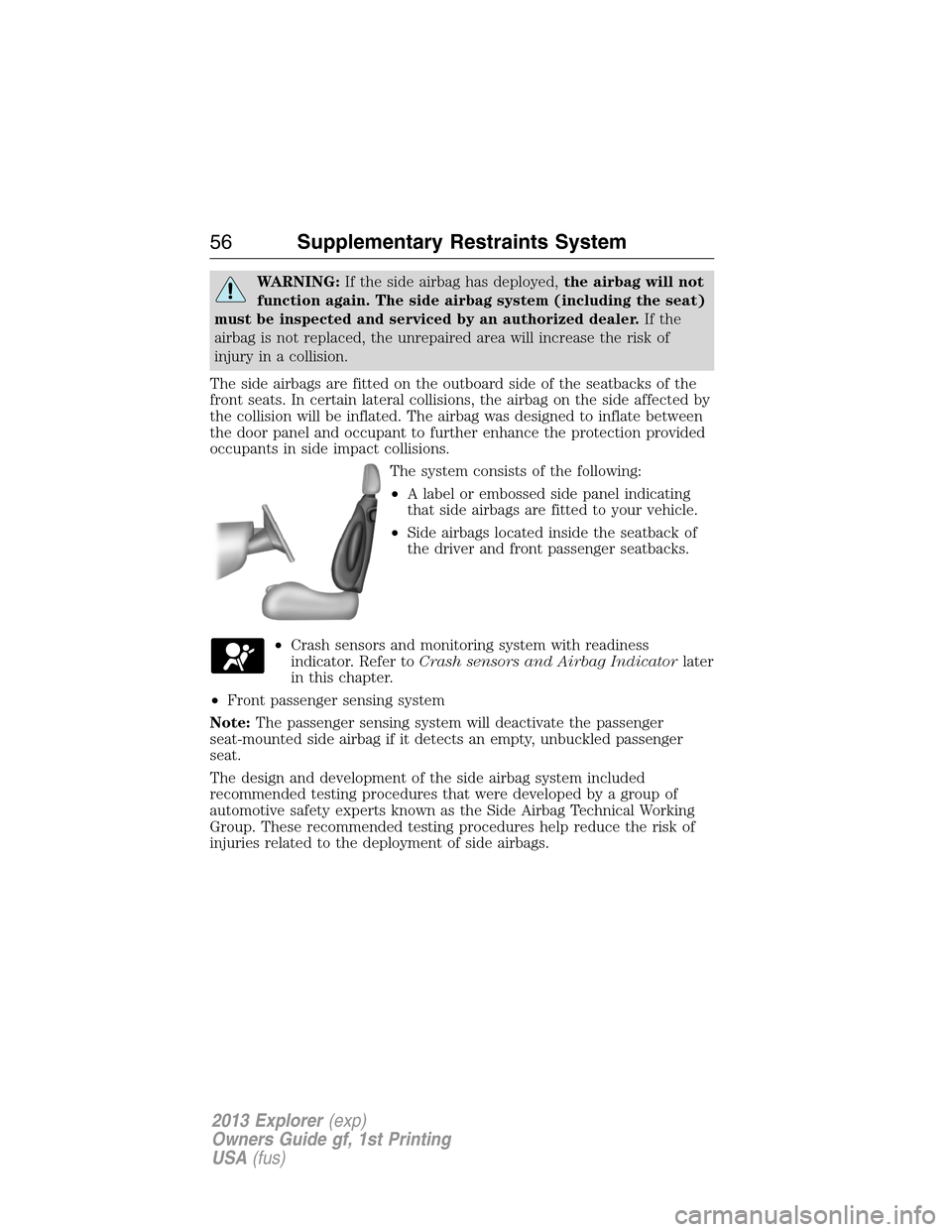
WARNING:If the side airbag has deployed,the airbag will not
function again. The side airbag system (including the seat)
must be inspected and serviced by an authorized dealer.If the
airbag is not replaced, the unrepaired area will increase the risk of
injury in a collision.
The side airbags are fitted on the outboard side of the seatbacks of the
front seats. In certain lateral collisions, the airbag on the side affected by
the collision will be inflated. The airbag was designed to inflate between
the door panel and occupant to further enhance the protection provided
occupants in side impact collisions.
The system consists of the following:
•A label or embossed side panel indicating
that side airbags are fitted to your vehicle.
•Side airbags located inside the seatback of
the driver and front passenger seatbacks.
•Crash sensors and monitoring system with readiness
indicator. Refer toCrash sensors and Airbag Indicatorlater
in this chapter.
•Front passenger sensing system
Note:The passenger sensing system will deactivate the passenger
seat-mounted side airbag if it detects an empty, unbuckled passenger
seat.
The design and development of the side airbag system included
recommended testing procedures that were developed by a group of
automotive safety experts known as the Side Airbag Technical Working
Group. These recommended testing procedures help reduce the risk of
injuries related to the deployment of side airbags.
56Supplementary Restraints System
2013 Explorer(exp)
Owners Guide gf, 1st Printing
USA(fus)